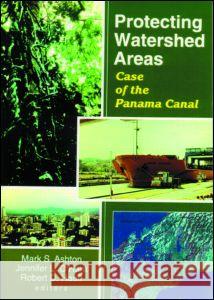Protecting Watershed Areas: Case of the Panama Canal » książka
Protecting Watershed Areas: Case of the Panama Canal
ISBN-13: 9781560220664 / Angielski / Miękka / 1999 / 236 str.
Protecting Watershed Areas: Case of the Panama Canal
ISBN-13: 9781560220664 / Angielski / Miękka / 1999 / 236 str.
(netto: 194,27 VAT: 5%)
Najniższa cena z 30 dni: 201,44
ok. 22 dni roboczych
Dostawa w 2026 r.
Darmowa dostawa!
Protecting Watershed Areas: Case of the Panama Canal provides foresters, hydrologists, and park managers with a case study of the Panama Canal watershed area to help you make the most of your efforts in protecting ecological areas. Through this unique book, you will discover how the Carter-Torrijos treaty that will return the Panama Canal to the Republic of Panama on December 31, 1999 will affect the 2.6 million inhabitants of that area as well as this complex ecosystem. This valuable book includes a focus on both technical and biological observations in the field as well as library research to help you make the most of book learning and field research in your endeavors to protect forest reserves and other protected areas. Protecting Watershed Areas offers you insight into the Panama Canal area through informal interviews, key informants, field data, and research that focuses on both the technical and biological aspects of environmental management, such as agroforestry and reforestation, of environmental management and on policy and institutional dimensions of management to provide you with a unique perspective of the dynamics of this area. The Panama canal watershed area is one of the world's most complex managed ecosystems and through this insightful volume, you will find new ways to deal with the myriad of problems you may encounter in ecosystem management, such as:
- realizing that single resource management is no longer adequate and taking a more holistic approach to management, such as taking into consideration whole ecosystems or watersheds will enable you to fully protect the area you are trying to serve
- discovering how the trend of privitization and nongovernmental ownership of protected areas impacts the job of managing our precious national resources
- understanding that for effective and stable protected area management to occur, you must have a clear understanding of the historical and social context that has shaped the particular circumstances of each site
- recognizing larger national and international factors in order to control the often devastating effects of tourism on protected areas
- creating clear directives and priorities before developing conservation programs to make program implementation easierInformative and insightful, Protecting Watershed Areas examines the most current ideas in protected areas management through a unique case study of the Panama Canal. This essential book provides you with several answers to the challenges facing Panama that you can apply to forest reserve and other protected areas programs around the globe due to the paramount importance of developing sustainable land-use systems. With Protecting Watershed Areas, you will discover how to effectively balance securing goods and services from a region, such as farming and tourism without threatening the overall integrity of the ecological systems and meeting human needs and values.
Protecting Watershed Areas: Case of the Panama Canal provides foresters, hydrologists, and park managers with a case study of the Panama Canal watershed area to help you make the most of your efforts in protecting ecological areas. Through this unique book, you will discover how the Carter-Torrijos treaty that will return the Panama Canal to the Republic of Panama on December 31, 1999 will affect the 2.6 million inhabitants of that area as well as this complex ecosystem. This valuable book includes a focus on both technical and biological observations in the field as well as library research to help you make the most of book learning and field research in your endeavors to protect forest reserves and other protected areas. Protecting Watershed Areas offers you insight into the Panama Canal area through informal interviews, key informants, field data, and research that focuses on both the technical and biological aspects of environmental management, such as agroforestry and reforestation, of environmental management and on policy and institutional dimensions of management to provide you with a unique perspective of the dynamics of this area. The Panama canal watershed area is one of the world?s most complex managed ecosystems and through this insightful volume, you will find new ways to deal with the myriad of problems you may encounter in ecosystem management, such as:
- realizing that single resource management is no longer adequate and taking a more holistic approach to management, such as taking into consideration whole ecosystems or watersheds will enable you to fully protect the area you are trying to serve
- discovering how the trend of privitization and nongovernmental ownership of protected areas impacts the job of managing our precious national resources
- understanding that for effective and stable protected area management to occur, you must have a clear understanding of the historical and social context that has shaped the particular circumstances of each site
- recognizing larger national and international factors in order to control the often devastating effects of tourism on protected areas
- creating clear directives and priorities before developing conservation programs to make program implementation easierInformative and insightful, Protecting Watershed Areas examines the most current ideas in protected areas management through a unique case study of the Panama Canal. This essential book provides you with several answers to the challenges facing Panama that you can apply to forest reserve and other protected areas programs around the globe due to the paramount importance of developing sustainable land-use systems. With Protecting Watershed Areas, you will discover how to effectively balance securing goods and services from a region, such as farming and tourism without threatening the overall integrity of the ecological systems and meeting human needs and values.











